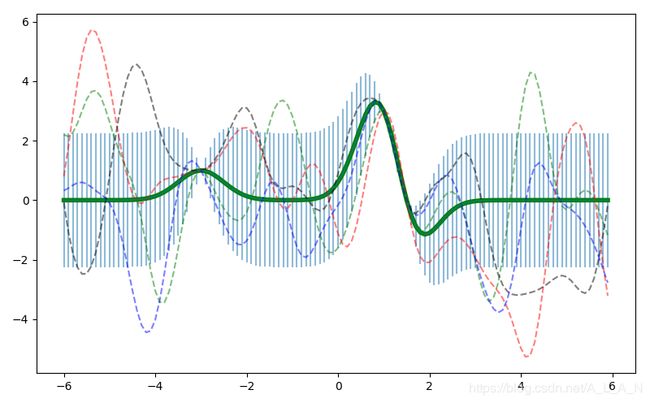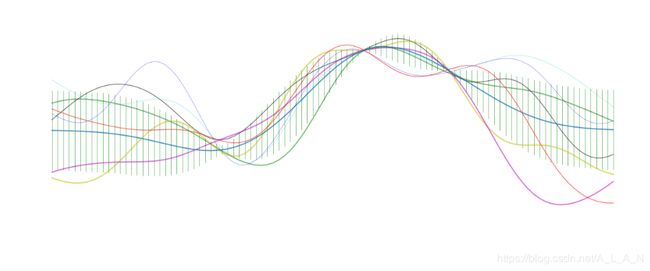高斯过程回归GPR(sklearn.gaussian_process+python实现)
1、高斯过程:
scikit-learn (sklearn) 官方文档
scikit-learn (sklearn) 官方文档中文版
scikit-learn (sklearn) 官方文档中文版(1.7. 高斯过程)
其他介绍:
A Visual Exploration of Gaussian Processes
看得见的高斯过程:这是一份直观的入门解读(上面中文翻译-机器之心)
Introduction to Gaussian Processes - Part I
从数学到实现,全面回顾高斯过程中的函数最优化(机器之心)
浅谈高斯过程回归
相关paper:
Gaussian Processes for Regression A Quick Introduction, M.Ebden, August 2008.
[RW2006] Carl Eduard Rasmussen and Christopher K.I. Williams, “Gaussian Processes for Machine Learning”, MIT Press 2006.
2、python实现:
(例1)
import numpy as np
import matplotlib.pyplot as plt
from sklearn.gaussian_process import GaussianProcessRegressor
from sklearn.gaussian_process.kernels import RBF, ConstantKernel as C
from mpl_toolkits.mplot3d import Axes3D
# 创建数据集
test = np.array([[2004, 98.31]])
data = np.array([
[2001, 100.83, 410], [2005, 90.9, 500], [2007, 130.03, 550], [2004, 78.88, 410], [2006, 74.22, 460],
[2005, 90.4, 497], [1983, 64.59, 370], [2000, 164.06, 610], [2003, 147.5, 560], [2003, 58.51, 408],
[1999, 95.11, 565], [2000, 85.57, 430], [1995, 66.44, 378], [2003, 94.27, 498], [2007, 125.1, 760],
[2006, 111.2, 730], [2008, 88.99, 430], [2005, 92.13, 506], [2008, 101.35, 405], [2000, 158.9, 615]])
# 核函数的取值
kernel = C(0.1, (0.001, 0.1)) * RBF(0.5, (1e-4, 10))
# 创建高斯过程回归,并训练
reg = GaussianProcessRegressor(kernel=kernel, n_restarts_optimizer=10, alpha=0.1)
reg.fit(data[:, :-1], data[:, -1])
# 创建一个作图用的网格的测试数据,数据位线性,x为【1982,2009】间隔位0.5;y为【57.5,165】间隔位0.5
x_min, x_max = data[:, 0].min() - 1, data[:, 0].max() + 1
y_min, y_max = data[:, 1].min() - 1, data[:, 1].max() + 1
xset, yset = np.meshgrid(np.arange(x_min, x_max, 0.5), np.arange(y_min, y_max, 0.5))
# 查看网格测试数据输出结果,并返回标准差。
output, err = reg.predict(np.c_[xset.ravel(), yset.ravel()], return_std=True)
output, err = output.reshape(xset.shape), err.reshape(xset.shape)
sigma = np.sum(reg.predict(data[:, :-1], return_std=True)[1])
up, down = output * (1 + 1.96 * err), output * (1 - 1.96 * err)
# 作图,并画出
fig = plt.figure(figsize=(10.5, 5))
ax1 = fig.add_subplot(121, projection='3d')
surf = ax1.plot_wireframe(xset, yset, output, rstride=10, cstride=2, antialiased=True)
surf_u = ax1.plot_wireframe(xset, yset, up, colors='lightgreen', linewidths=1,
rstride=10, cstride=2, antialiased=True)
surf_d = ax1.plot_wireframe(xset, yset, down, colors='lightgreen', linewidths=1,
rstride=10, cstride=2, antialiased=True)
ax1.scatter(data[:, 0], data[:, 1], data[:, 2], c='red')
ax1.set_title('House Price at (2004, 98.31): {0:.2f}$*10^4$ RMB'.format(reg.predict(test)[0]))
ax1.set_xlabel('Year')
ax1.set_ylabel('Area, $m^2$')
plt.show()
结果:
(例2)
import numpy as np
import matplotlib.pyplot as plt
from sklearn.gaussian_process.kernels import RBF, ConstantKernel as C
from sklearn.gaussian_process import GaussianProcessRegressor
# Build a model
kernel = C(1.0, (1e-3, 1e3)) * RBF(10, (0.5, 2))
gp = GaussianProcessRegressor(kernel=kernel, n_restarts_optimizer=9)
# Some data
xobs = np.array([[1], [1.5], [-3]])
yobs = np.array([3, 0, 1])
# Fit the model to the data (optimize hyper parameters)
gp.fit(xobs, yobs)
# Plot points and predictions
x_set = np.arange(-6, 6, 0.1)
x_set = np.array([[i] for i in x_set])
means, sigmas = gp.predict(x_set, return_std=True)
plt.figure(figsize=(8, 5))
plt.errorbar(x_set, means, yerr=sigmas, alpha=0.5)
plt.plot(x_set, means, 'g', linewidth=4)
colors = ['g', 'r', 'b', 'k']
for c in colors:
y_set = gp.sample_y(x_set, random_state=np.random.randint(1000))
plt.plot(x_set, y_set, c + '--', alpha=0.5)
plt.show()
结果:
(例3)
import numpy as np
import matplotlib.pyplot as plt
from scipy.interpolate import spline
from scipy.linalg import cho_solve
from numpy.linalg import cholesky
from itertools import cycle
class SimpleGP():
""" One dimensional Gaussian Process class. Uses
squared exponential covariance form.
parameters
----------
width_scale : float, positive
Same as sigma in (4) of post
length_scale : float, positive
Same as l in (4) of post
noise : float
Added to diagonal of covariance, useful for
improving convergence
"""
def __init__(self, width_scale, length_scale, noise=10 ** (-6)):
self.width_scale = width_scale
self.length_scale = length_scale
self.noise = noise
def _exponential_cov(self, x1, x2):
"""
Return covariance matrix for two arrays,
with i-j element = cov(x_1i, x_2j).
parameters
----------
x1, x2: np.array
arrays containing x locations
"""
return (self.width_scale ** 2) * np.exp(
- np.subtract.outer(x1, x2) ** 2 / (2 * self.length_scale ** 2))
def fit(self, sample_x, sample_y, sample_s):
"""
Save for later use the Cholesky matrix
associated with the inverse that appears
in (5) of post. Also evaluate the weighted
y vector that appears in that equation.
parameters
----------
sample_x : np.array
locations where we have sampled
sample_y : np.array
y values observed at each sample location
sample_s : np.array
array of stds for each sample
"""
self.sample_x = np.array(sample_x)
S = self._exponential_cov(sample_x, sample_x)
d = np.diag(np.array(sample_s) ** 2 + self.noise)
self.lower_cholesky = cholesky(S + d)
self.weighted_sample_y = cho_solve(
(self.lower_cholesky, True), sample_y)
def interval(self, test_x):
"""
Obtain the one-sigam confidence interval
for a set of test points
parameters
----------
test_x : np.array
locations where we want to test
"""
test_x = np.array([test_x]).flatten()
means, stds = [], []
for row in test_x:
S0 = self._exponential_cov(row, self.sample_x)
v = cho_solve((self.lower_cholesky, True), S0)
means.append(np.dot(S0, self.weighted_sample_y))
stds.append(np.sqrt(self.width_scale ** 2 - np.dot(S0, v)))
return means, stds
def sample(self, test_x, samples=1):
"""
Obtain function samples from the posterior
parameters
----------
test_x : np.array
locations where we want to test
samples : int
Number of samples to take
"""
S0 = self._exponential_cov(test_x, self.sample_x)
# construct covariance matrix of sampled points.
m = []
for row in S0:
m.append(cho_solve((self.lower_cholesky, True), row))
cov = self._exponential_cov(test_x, test_x) - np.dot(S0, np.array(m).T)
mean = np.dot(S0, self.weighted_sample_y)
return np.random.multivariate_normal(mean, cov, samples)
# Insert data here.
sample_x = [0.5, 2, -2]
sample_y = [2, 1.5, -0.5]
sample_s = [0.01, 0.05, 0.125]
WIDTH_SCALE = 1
LENGTH_SCALE = 1
SAMPLES = 8
model = SimpleGP(WIDTH_SCALE, LENGTH_SCALE)
model.fit(sample_x, sample_y, sample_s)
test_x = np.arange(-5, 5, .1)
means, stds = model.interval(test_x)
samples = model.sample(test_x, SAMPLES)
# plots here.
fig, ax = plt.subplots(figsize=(12, 5))
ax.set_ylim([-3, 3])
ax.axis('off')
colors = cycle(['g', 'b', 'k', 'y', 'c', 'r', 'm'])
plt.errorbar(test_x, means, yerr=stds,
ecolor='g', linewidth=1.5,
elinewidth=0.5, alpha=0.75)
for sample, c in zip(samples, colors):
plt.plot(test_x, sample, c, linewidth=2. * np.random.rand(), alpha=0.5)
plt.show()
结果:
C++库:
github地址:https://github.com/resibots/limbo
Documentation:http://www.resibots.eu/limbo
参考:
python.sklearn.gaussian_process高斯过程回归的调用
https://github.com/EFavDB/gaussian_processes/blob/master/GP_example.ipynb


